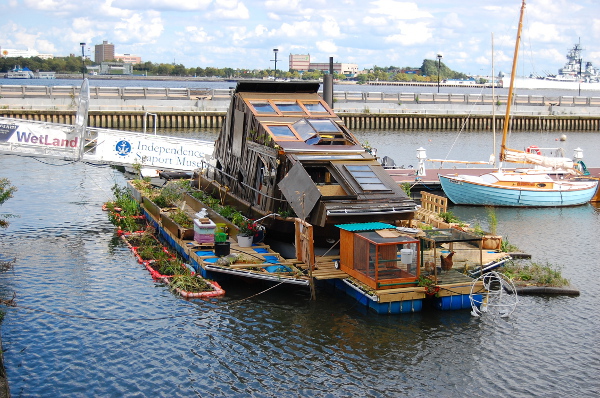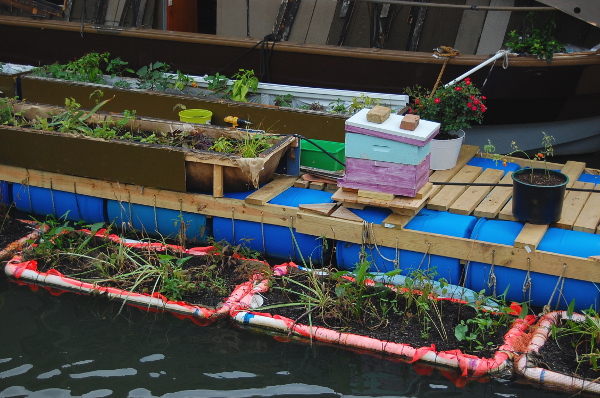
WetLand: a buoyant urban ecosystem and artist’s residence on the Delaware
If it looks like there’s a house sinking into the Delaware River at the Independence Seaport Museum Dock, that would actually be half true. Artist Mary Mattingly will be residing in the shack-like floating dwelling for the duration of FringeArts this September. The Knight Arts grantee project entitled “WetLand” is an experiment in sustainability and urban life during an era of increasingly crucial environmental concern. With habitat destruction and climate change threatening both our contemporary lives and the environment at large, Mattingly’s high-visibility message is a manifold and relevant one. A view of “WetLand” in the Independence Seaport Museum Dock.
For the abode itself, it includes rainwater collection and purification systems, greywater filtration, composting setups, a bee hive, a chicken coop, outdoor vegetable gardens and indoor hydroponics gardens. Tapping into the attitudes of those segments of the population that are increasingly growing their own food and highlighting the systems of consumption and production, “WetLand” draws from sources of inspiration as different as Rachel Carson’s conservationist calls to action and H. Buckminster Fuller’s forward-thinking houses. The result is a fusion of many disciplines into one sound vision with the future solidly in its sights.
Assembled with ideas of architecture, art and ecology in mind, “WetLand” serves numerous functions as an example of an environmentally sound living space, an art installation built from repurposed materials, and a performance location all in one. It is a mobile public space constructed to look somewhat like a house half submerged in the river, reminding us that, whether we can see the day-to-day changes of rising sea levels or not, they are very real and potentially extremely dire. By titling the project “WetLand,” Mattingly also hopes to help draw attention to the worldwide epidemic of shrinking wetlands worldwide. These locations provide not only biologically diverse grounds for aquatic and terrestrial life, but also storm buffers for mainland areas.
Outdoor gardens and a bee hive on the exterior of “WetLand.”
Wetlands are important transitional ecosystems that clean air and waterways, but Mattingly’s title also hints at a secondary, more dubious meaning. If we do not check our carbon emissions and begin treating the earth with the respect it deserves, many of our cities may become quite wet as well, as water levels overtake many heavily populated, low-elevation regions. By collaborating with a number of other artists to assemble a structure and ultimately a real-time, functional, self-sustaining settlement, Mattingly is also constructing a community.
Throughout the duration of “WetLand,” Mattingly and other artists will present a series of concerts, workshops, performances and skills shares in order to directly engage the larger world that exists beyond the installation’s island microcosm. While many of us may see ourselves as part of a concrete jungle that exists as cut off and somehow separated from nature, Mattingly assures us that our deeds and their repercussions move far beyond the cities in which we live. Whether we consider our agricultural impacts, the side-effects of burning massive amounts of fossil fuels, or just the resource interdependency that keeps society in motion, it is clear that our existence on this planet is hugely influential… and oftentimes not for the best.
Check out the “WetLand” calendar for a full list of upcoming events and be sure to stop by the harbor to see the buoyant habitation and its rotating cast of resident artists through September 21. If we each take something vital away from Mattingly’s project and put it to use, perhaps we can stop the deluge before our cities are wetlands and our wetlands are no more.
WetLand is located at the Independence Seaport Museum Dock, Philadelphia; [email protected]; [email protected]; wet-land.org; fringearts.com.
Recent Content
-
Artsarticle ·
-
Artsarticle ·
-
Artsarticle ·

